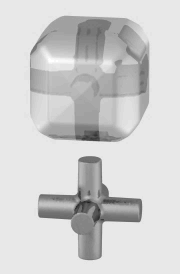Modeling

3D computer animation combines 3D models of objects and programmed or hand "keyframed" movement. These models are constructed out of geometrical vertices, faces, and edges in a 3D coordinate system. Objects are sculpted much like real clay or plaster, working from general forms to specific details with various sculpting tools. Unless a 3D model is intended to be a solid color, it must be painted with "textures" for realism. A bone/joint animation system is set up to deform the CGI model (e.g., to make a humanoid model walk). In a process known as rigging, the virtual marionette is given various controllers and handles for controlling movement. Animation data can be created using motion capture, or keyframing by a human animator, or a combination of the two.
3D models rigged for animation may contain thousands of control points — for example, "Woody" from Toy Story uses 700 specialized animation controllers. Rhythm and Hues Studios labored for two years to create Aslan in the movie The Chronicles of Narnia: The Lion, the Witch and the Wardrobe, which had about 1,851 controllers (742 in the face alone). In the 2004 film The Day After Tomorrow, designers had to design forces of extreme weather with the help of video references and accurate meteorological facts. For the 2005 remake of King Kong, actor Andy Serkis was used to help designers pinpoint the gorilla's prime location in the shots and used his expressions to model "human" characteristics onto the creature. Serkis had earlier provided the voice and performance for Gollum in J. R. R. Tolkien's The Lord of the Rings trilogy.
Comments
Post a Comment